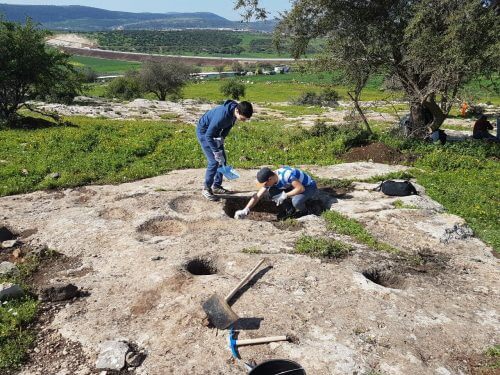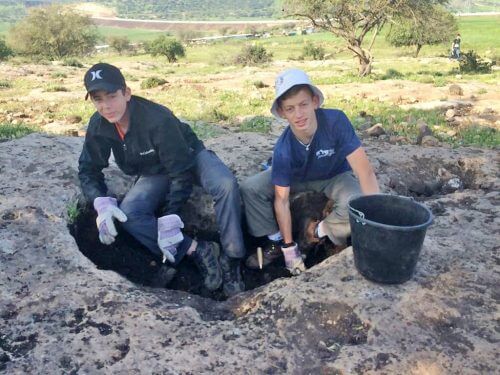More than 2,000 students from around the country have participated in archeological excavations with the Antiquities Authority in recent months and uncovered ancient structures carved into the rock, which were used to process agricultural produce. The archaeologists: "They produced wine here, or maybe even mustard oil"

About 2,000 students from all over the country - Jews, Arabs, Bedouin and Druze - participated in the last few months in archaeological excavations in Hukok in the Lower Galilee. The students uncovered an ancient industrial area, where ancient installations were carved into the rock, and were used to process the agricultural produce.
In the academic year XNUMX, the Antiquities Authority and the XNUMX Division ('שde-לum-חBarah) and Yediat Ha'aretz in the Ministry of Education, and for the first time, integrated the participation in archeological digs as part of the trip into the 'Significant Journey' program of the 65th grades. As part of the educational program, the students took part in a tour of the Khokok ruins near Highway XNUMX, between Kader Junction and Golani Junction. After that, dig at the edge of the hill under the guidance of archaeologists and guides from the Antiquities Authority. The excavation combined a valuable and meaningful experience with a research goal - locating the boundaries of the ancient settlement, and uncovering remains from all the periods in which a settlement existed in Hukok.
This is the first year that students are excavating in the Hakok ruin. In recent years, another significant archaeological excavation has been conducted on top of Givat Khokuk, by an excavation team from the University of North Carolina at Chapel Hill, USA, led by Prof. Judy Magness, and in collaboration with Shua Kisilevich from the Antiquities Authority. The excavation, and surveys conducted at the site, indicate that the site was already inhabited more than 4,000 years ago (Early Bronze Age). During the Roman and Byzantine periods (1st to 7th century CE), there was a Jewish village on the site, and in the expedition's excavation, the synagogue from the Byzantine period is being uncovered, decorated with unique mosaic floors depicting biblical and extra-biblical stories.

On the western side of the hill, the students uncovered agricultural facilities carved into the rock. According to Yoav Tzur, the director of the excavation on behalf of the Antiquities Authority, "As we expanded the excavation with the students, we found more and more facilities, and it seems that this is not a private use, but an actual industrial area, from the Middle Bronze Age (1800 BC) or from the Roman-Byzantine period (5nd-2th century AD). There is no doubt that the facilities were used to process agricultural produce from the surrounding area, but it is still unclear what their produce was. It is possible that these facilities were used as wine cellars for the production of wine from grapes. Another possibility is that mustard oil was produced there: Talmudic sources testify to the production of oil from the mustard plant that grew in the area, and was a source of livelihood for the residents of the Jewish village of Hakok."
Moshik Cohen, national inspector for the Ministry of Information and Knowledge of Israel, who was among the initiators of the program with the Antiquities Authority, believes that "the shared walk and belief in the inheritance and the connection of the youth to the land, to the heritage and to the people through the integration of archaeological excavations in trips and field days, has the potential to enhance the learning experience, alongside Strengthening and connecting the students to the land and its heritage." According to Cohen, "From my conversations with the teachers and students who participated in the program, I was deeply impressed by the significant experience and learning in the direct encounter with the heritage sites where the excavations took place. I have no doubt about the educational and value importance of the program."
At the foot of the Khokok ruin springs a Khokok spring, whose abundant waters were a major reason for the existence of a settlement on the site throughout the ages, and around the spring is a grove of large jujubes and a natural grove. In the future, development of the site and the spring is planned, for the benefit of the general public.

One response
We used a shovel with a compass so that we could reach the right areas without damaging the antiquities